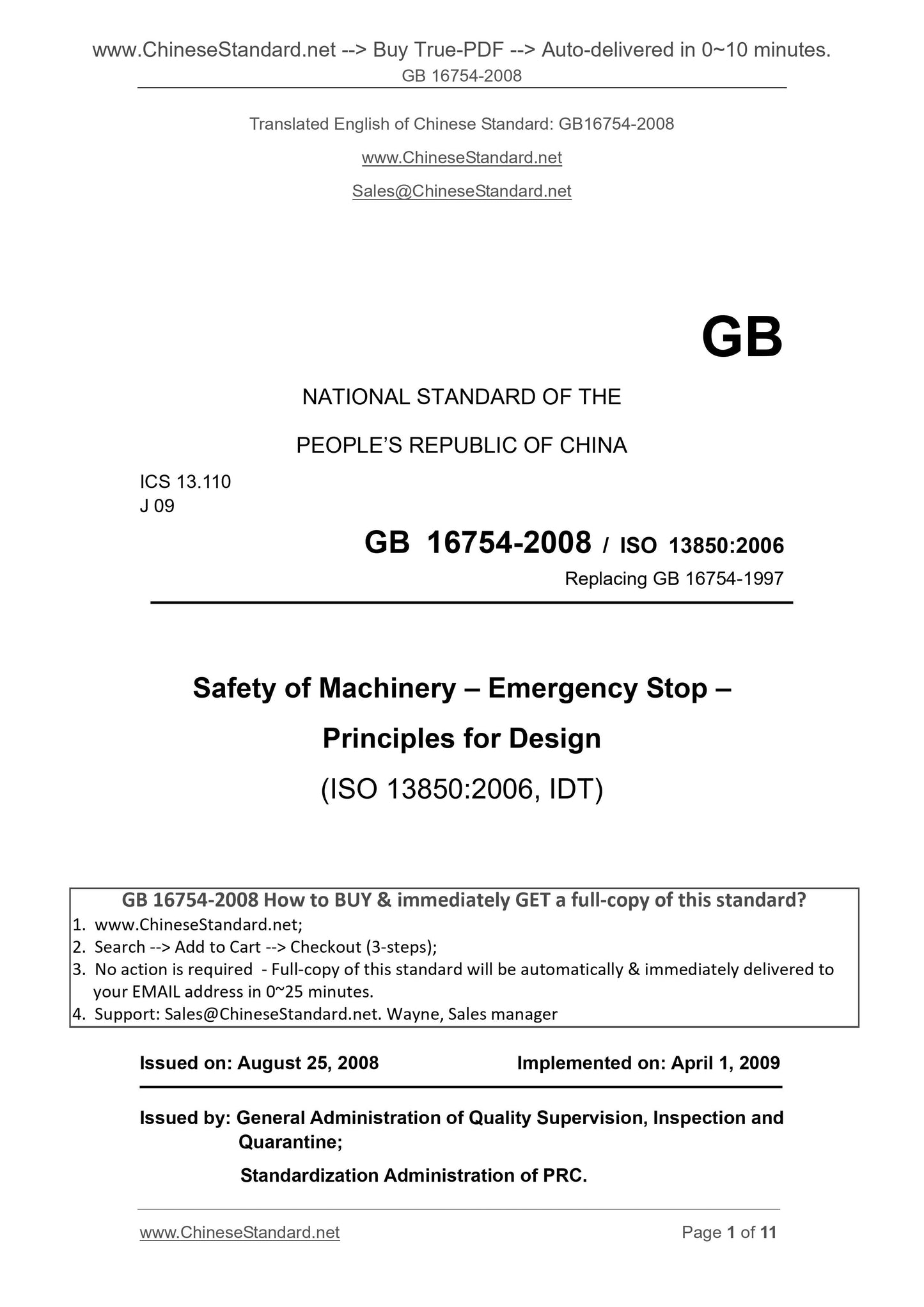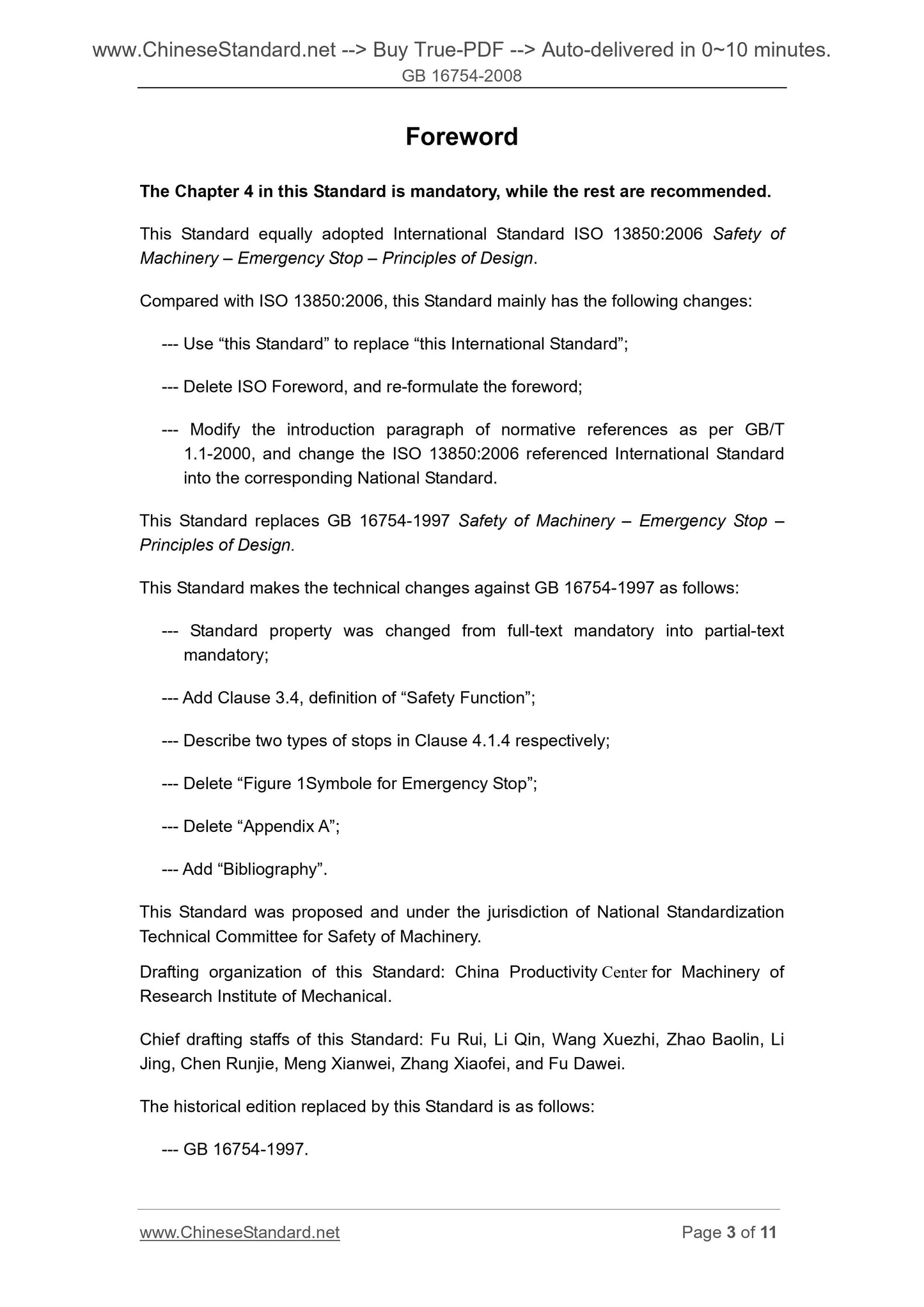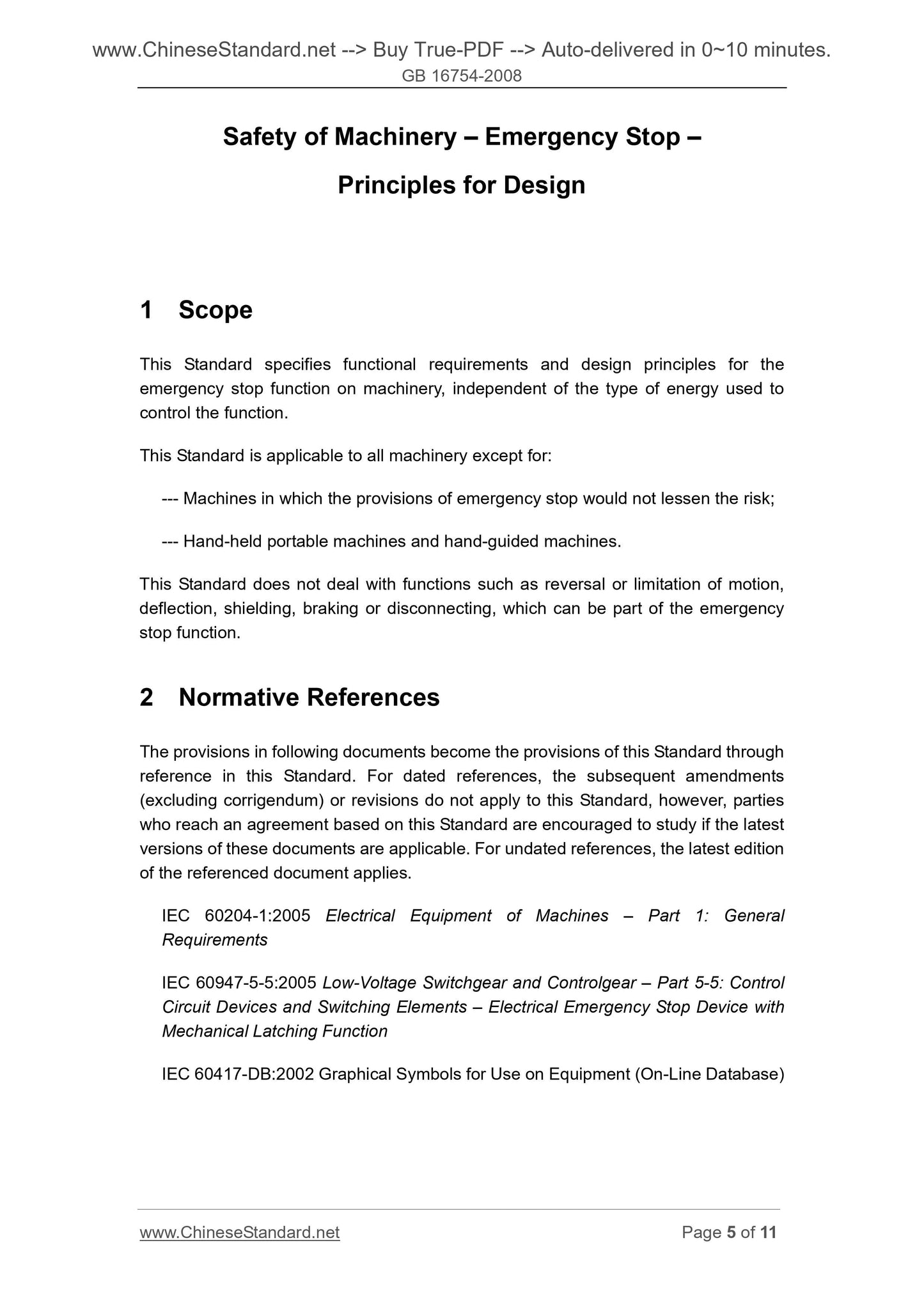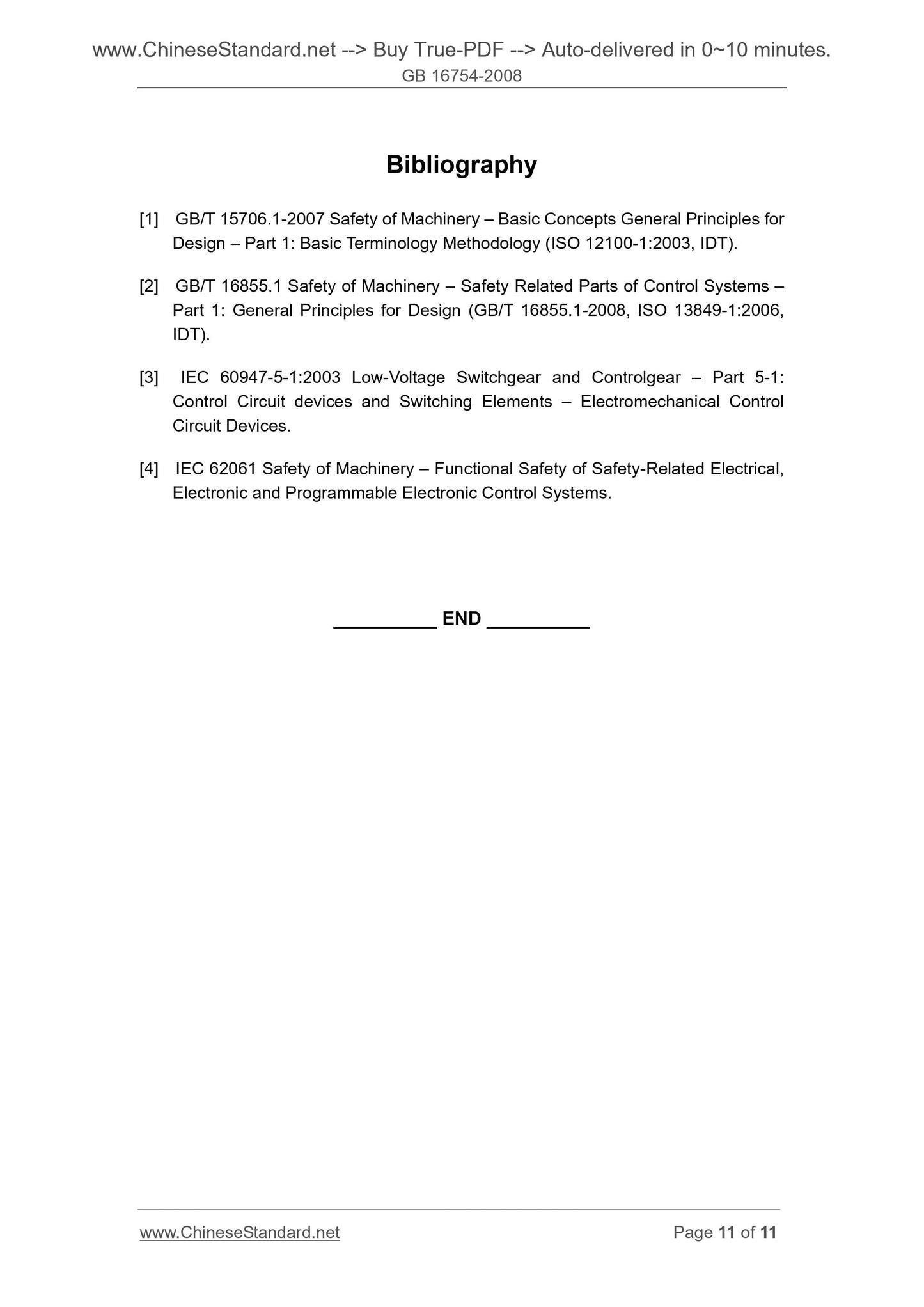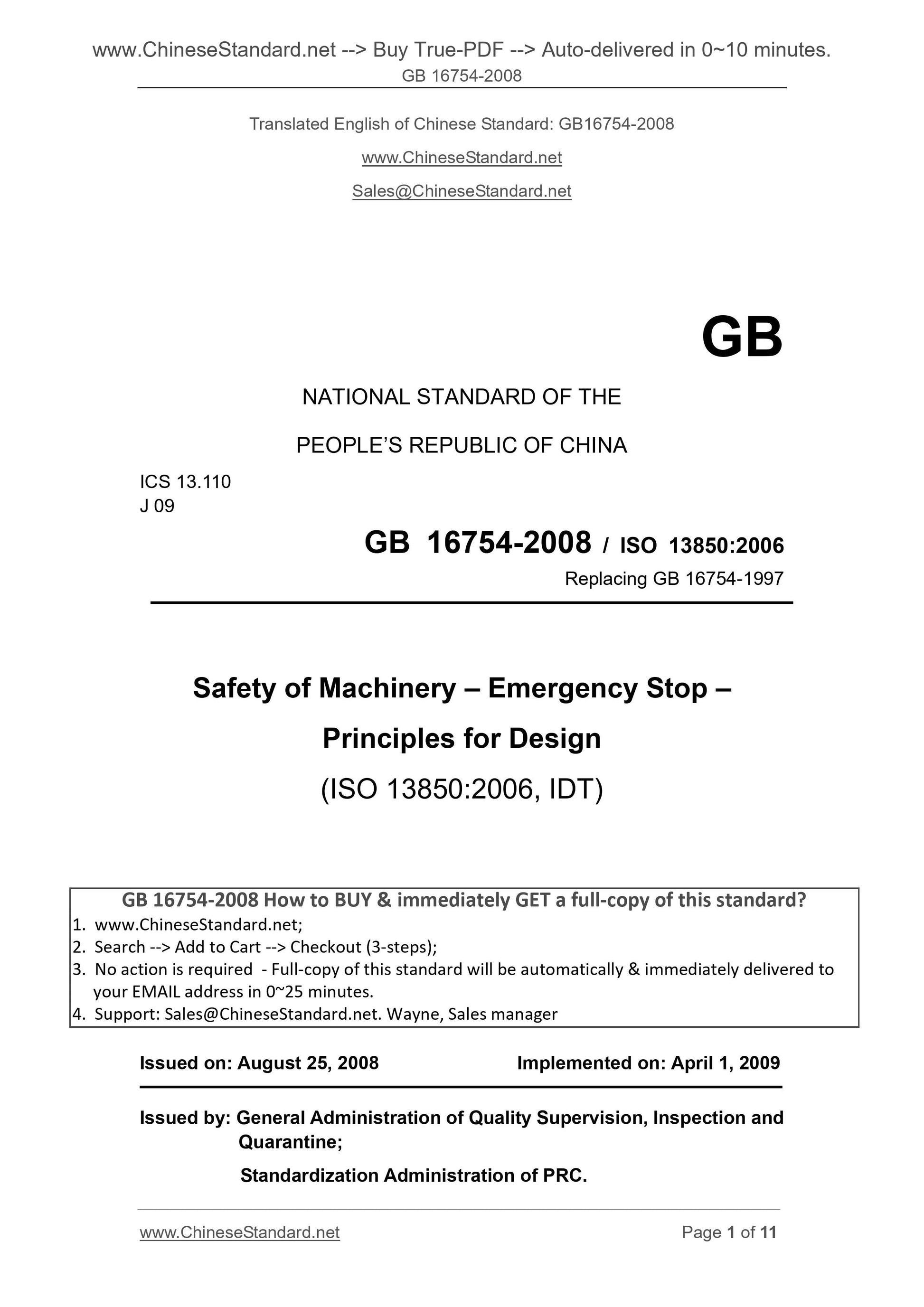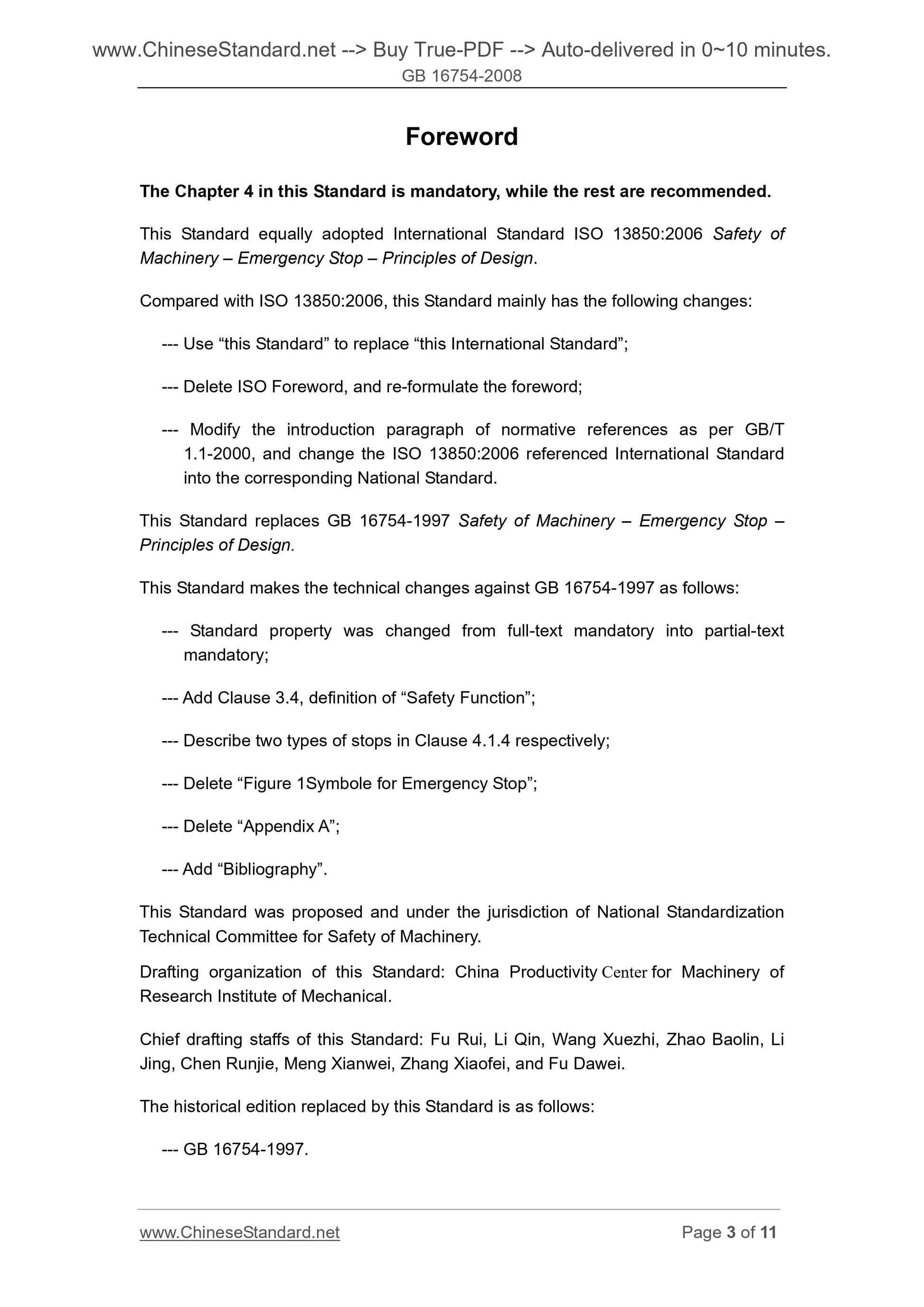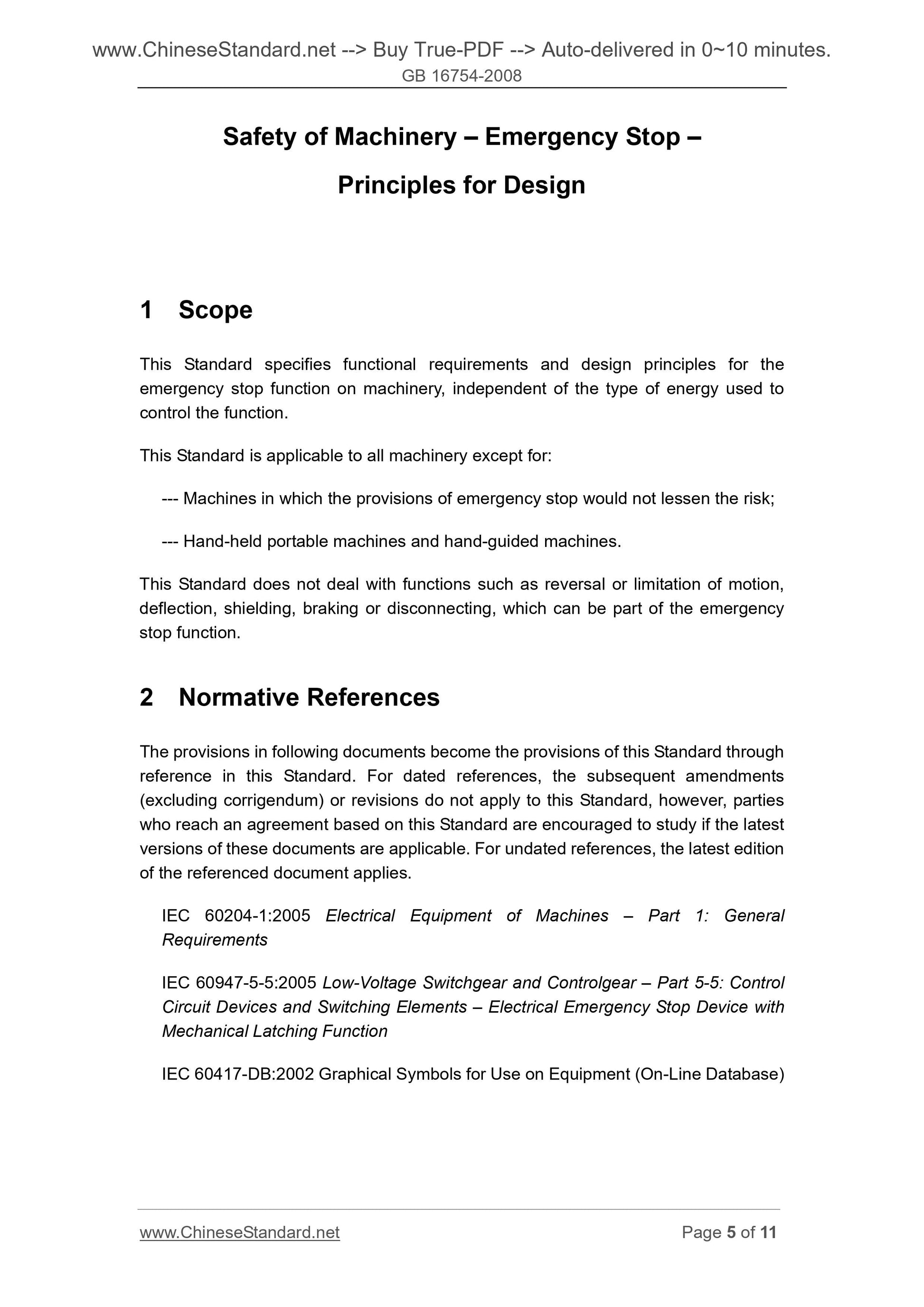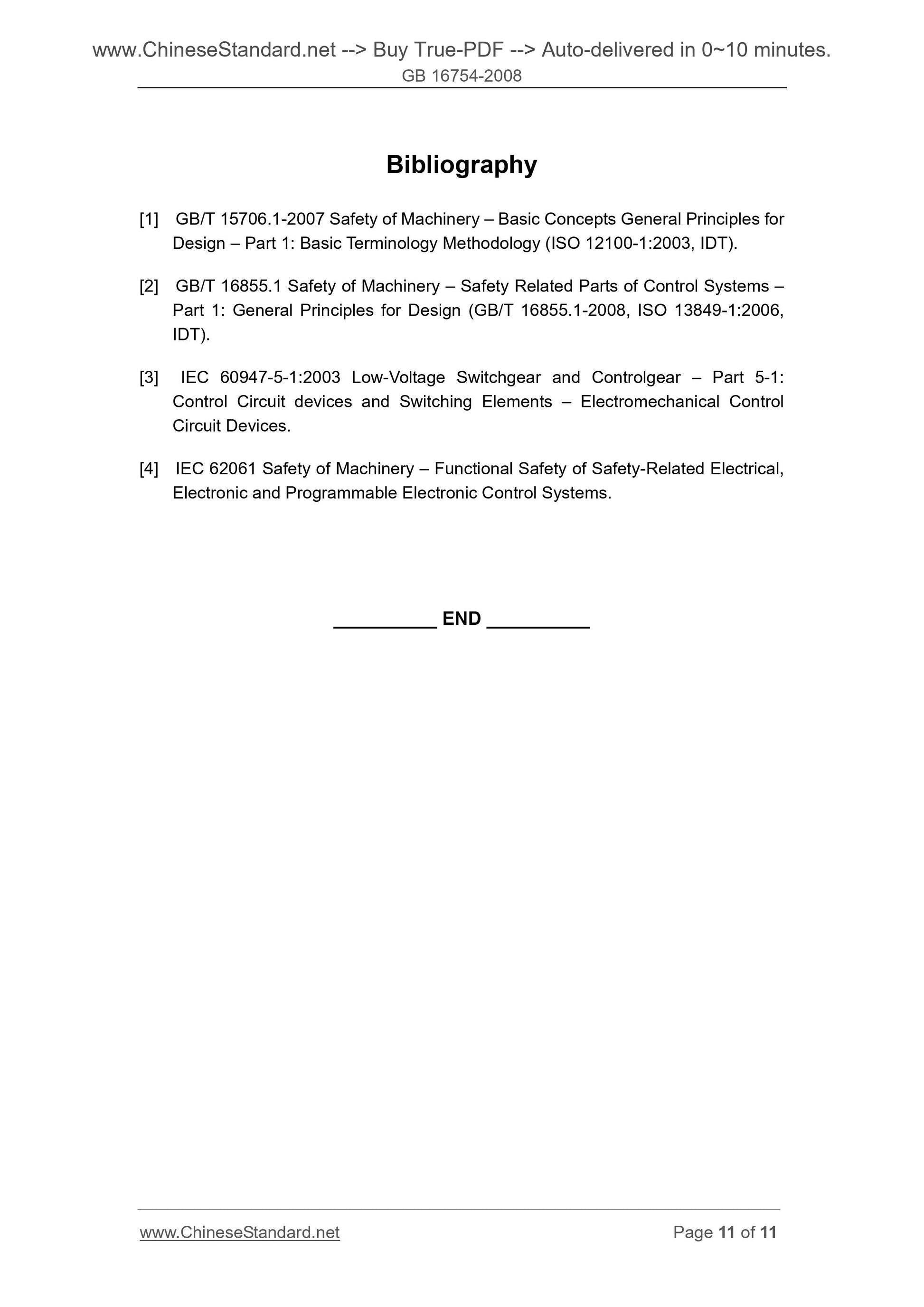1
/
of
6
PayPal, credit cards. Download editable-PDF and invoice in 1 second!
GB 16754-2008 English PDF (GB16754-2008)
GB 16754-2008 English PDF (GB16754-2008)
Regular price
$70.00 USD
Regular price
Sale price
$70.00 USD
Unit price
/
per
Shipping calculated at checkout.
Couldn't load pickup availability
Delivery: 3 seconds. Download true-PDF + Invoice.Newer version: (Replacing this standard) GB/T 16754-2021
Get QUOTATION in 1-minute: Click GB 16754-2008
Historical versions: GB 16754-2008
Preview True-PDF (Reload/Scroll if blank)
GB 16754-2008: [GB/T 16754-2008] Safety of machinery. Emergency stop. Principles for design
GB 16754-2008
Safety of machinery.Emergency stop.Principles for design
ICS 13.110
J09
National Standards of People's Republic of China
GB 16754-2008/ISO 13850.2006
Replacing GB 16754-1997
Safety of machinery - Emergency stop design principles
(ISO 13850.2006, IDT)
Posted 2008-08-25
2009-04-01 implementation
Administration of Quality Supervision, Inspection and Quarantine of People's Republic of China
Standardization Administration of China released
Table of Contents
Introduction Ⅲ
Introduction Ⅳ
1 Scope 1
2 Normative references 1
3 Terms and definitions
4 Safety Requirements
4.1 General Requirements 2
4.2 Emergency electrical equipment requirements 2
4.3 working conditions, environmental impact 3
4.4 Emergency stop device 3
4.5 using wire or rope as a control mechanism 3
Reference 5
GB 16754-2008/ISO 13850.2006
Foreword
Chapter 4 of this standard are mandatory, the rest are recommended.
This standard is equivalent to international standard ISO 13850.2006 "Safety of machinery - Emergency stop design principles."
This standard and ISO 13850.2006 mainly for the following points.
--- Use the "standard" instead of "this International Standard";
--- Deleted the ISO foreword, preface rewritten;
--- The Lead Normative documents according to GB/T 1.1-2000 modified and ISO 13850.2006 international references
Standard to the corresponding national standards.
This standard replaces GB 16754-1997 "Safety of machinery - Emergency stop design principles."
This standard GB 16754-1997 made the following technical modifications.
--- Standard attributes from the text becomes mandatory provisions mandatory;
--- Increased by 3.4 "Security features" is defined;
--- 4.1.4 The two types of downtime were discussed separately;
--- Remove the "emergency stop function graphical representation of FIG. 1";
--- Removed "Appendix A";
--- Added "References."
This standard by the national security machinery Standardization Technical Committee and centralized.
This standard was drafted. Mechanical Science Research Institute of Machine Productivity Promotion Center.
The main drafters of this standard. Fu Rui, Li Qin, Yan Ning, ROCKETS, Zhao Baolin, Li Jing, Chen Runjie, Meng Wei, Zhang Xiaofei, pay much.
This standard replaces the standards previously issued as follows.
--- GB 16754-1997.
GB 16754-2008/ISO 13850.2006
introduction
Machinery safety standard is structured as follows.
--- A class standard (basic safety standards) give basic concepts apply to all mechanical, design principles and general characteristics.
--- B class standard (generic safety standards), it relates to a mechanical safety feature or use a wide range of safety devices in class.
● B1 class, specific security features (e.g., safety distance, surface temperature, noise) standard;
● B2 class, the safety device (such as a hand control devices, interlocking devices, pressure sensitive devices, guards).
--- C class standards (machine safety standards), for a particular machine or group of machines shall specify detailed safety standard requirements.
According to GB/T 15706.1, the present standards are B2 standard.
For Class C in accordance with the standard design and construction of the machine, if the C class standards in terms of Class A or Class B standards are inconsistent, priority
Using C standard.
This standard includes reference.
GB 16754-2008/ISO 13850.2006
Safety of machinery - Emergency stop design principles
1 Scope
This standard specifies the functions and control the energy used in the form of independent emergency stop functional requirements and design principles.
This standard applies to all machinery except the following two types of machines.
--- Emergency stop function can not reduce the risk of the machine;
--- Handheld machines and hand-guided machines.
This standard does not involve reversal may be part of the emergency stop function, restrict movement, deflection, shielding, braking or disconnecting functions.
2 Normative references
The following documents contain provisions which, through reference in this standard and become the standard terms. For dated references, subsequent
Amendments (not including errata content) or revisions do not apply to this section, however, encourage the parties to this part of the research agreement
Whether the latest versions of these documents, undated reference documents, the latest versions apply to this section.
IEC 60204-1.2005 Safety of machinery - Electrical equipment - Part 1. General requirements
IEC 60947-5-5.2005 Low-voltage switchgear and control equipment Part 5-5. Control circuit devices and switching elements having a machine
Mechanical latching function electrical emergency braking device
IEC 60417-DB.2002 Graphical symbols for equipment (online database)
3 Terms and Definitions
The following terms and definitions apply to this standard.
3.1
Predetermined stop function is.
--- Avoid or reduce the dangers of human existence, or mechanical damage to work in progress;
--- By the single action trigger.
Note 1. The danger may arise within the meaning of this standard in the following situations.
--- Dysfunction (such as mechanical failure, performance is substandard materials processing, human error);
---normal operation.
Note 2. According to GB/T 15706.1-2007, definitions 3.37.
3.2
Start-stop function for manual control means.
[IEC 60947-5-5.2005, the definition 3.2]
3.3
The machine used to generate motion power sector.
[IEC 60204-1.2005, definitions 3.32]
GB 16754-2008/ISO 13850.2006
3.4
Immediately after the failure will result in an increased risk of machine functions.
[GB/T 15706.1-2007, the definition 3.28]
4 Safety requirements
4.1 General Requirements
4.1.1 The emergency stop function shall be available at any time and operable in all modes of operation of the machine, this function should take precedence over all
Other features and convenience should not undermine any danger for the relief personnel and design. Emergency stop function until a manual reset before any
Start command (scheduled, unscheduled or unexpected) of those operations due to an emergency stop function and stopping should be invalid.
When the emergency stop devices may be split (for example, a portable suspended operation panel) may be partially or mechanical when isolated, should be taken to avoid running
And confusion between the control device is not running.
4.1.2 The emergency stop function should not be used in place security measures and other security features, and protective measures should be designed as a supplement. EMERGENCY
Function should not undermine the effectiveness of protective devices or with other safety function of the device.
Note. For this purpose, it is necessary to ensure that auxiliary equipment (such as. magnetic chuck or braking device) in continuous operation.
4.1.3 based on risk assessment, emergency stop function shall be designed such that after the emergency stop means is operated in an appropriate way to stop the dangerous movement of the machine
And operating without creating additional risks, and without further intervention anyone.
The "right way" may include.
--- Select the most appropriate deceleration rate;
--- Select stop category (see 4.1.4);
--- Applying a predetermined shutdown sequence.
Emergency stop function shall be designed so that the machine operator to consider when making a decision to use emergency stop devices, without considering the impact of the results.
4....
Get QUOTATION in 1-minute: Click GB 16754-2008
Historical versions: GB 16754-2008
Preview True-PDF (Reload/Scroll if blank)
GB 16754-2008: [GB/T 16754-2008] Safety of machinery. Emergency stop. Principles for design
GB 16754-2008
Safety of machinery.Emergency stop.Principles for design
ICS 13.110
J09
National Standards of People's Republic of China
GB 16754-2008/ISO 13850.2006
Replacing GB 16754-1997
Safety of machinery - Emergency stop design principles
(ISO 13850.2006, IDT)
Posted 2008-08-25
2009-04-01 implementation
Administration of Quality Supervision, Inspection and Quarantine of People's Republic of China
Standardization Administration of China released
Table of Contents
Introduction Ⅲ
Introduction Ⅳ
1 Scope 1
2 Normative references 1
3 Terms and definitions
4 Safety Requirements
4.1 General Requirements 2
4.2 Emergency electrical equipment requirements 2
4.3 working conditions, environmental impact 3
4.4 Emergency stop device 3
4.5 using wire or rope as a control mechanism 3
Reference 5
GB 16754-2008/ISO 13850.2006
Foreword
Chapter 4 of this standard are mandatory, the rest are recommended.
This standard is equivalent to international standard ISO 13850.2006 "Safety of machinery - Emergency stop design principles."
This standard and ISO 13850.2006 mainly for the following points.
--- Use the "standard" instead of "this International Standard";
--- Deleted the ISO foreword, preface rewritten;
--- The Lead Normative documents according to GB/T 1.1-2000 modified and ISO 13850.2006 international references
Standard to the corresponding national standards.
This standard replaces GB 16754-1997 "Safety of machinery - Emergency stop design principles."
This standard GB 16754-1997 made the following technical modifications.
--- Standard attributes from the text becomes mandatory provisions mandatory;
--- Increased by 3.4 "Security features" is defined;
--- 4.1.4 The two types of downtime were discussed separately;
--- Remove the "emergency stop function graphical representation of FIG. 1";
--- Removed "Appendix A";
--- Added "References."
This standard by the national security machinery Standardization Technical Committee and centralized.
This standard was drafted. Mechanical Science Research Institute of Machine Productivity Promotion Center.
The main drafters of this standard. Fu Rui, Li Qin, Yan Ning, ROCKETS, Zhao Baolin, Li Jing, Chen Runjie, Meng Wei, Zhang Xiaofei, pay much.
This standard replaces the standards previously issued as follows.
--- GB 16754-1997.
GB 16754-2008/ISO 13850.2006
introduction
Machinery safety standard is structured as follows.
--- A class standard (basic safety standards) give basic concepts apply to all mechanical, design principles and general characteristics.
--- B class standard (generic safety standards), it relates to a mechanical safety feature or use a wide range of safety devices in class.
● B1 class, specific security features (e.g., safety distance, surface temperature, noise) standard;
● B2 class, the safety device (such as a hand control devices, interlocking devices, pressure sensitive devices, guards).
--- C class standards (machine safety standards), for a particular machine or group of machines shall specify detailed safety standard requirements.
According to GB/T 15706.1, the present standards are B2 standard.
For Class C in accordance with the standard design and construction of the machine, if the C class standards in terms of Class A or Class B standards are inconsistent, priority
Using C standard.
This standard includes reference.
GB 16754-2008/ISO 13850.2006
Safety of machinery - Emergency stop design principles
1 Scope
This standard specifies the functions and control the energy used in the form of independent emergency stop functional requirements and design principles.
This standard applies to all machinery except the following two types of machines.
--- Emergency stop function can not reduce the risk of the machine;
--- Handheld machines and hand-guided machines.
This standard does not involve reversal may be part of the emergency stop function, restrict movement, deflection, shielding, braking or disconnecting functions.
2 Normative references
The following documents contain provisions which, through reference in this standard and become the standard terms. For dated references, subsequent
Amendments (not including errata content) or revisions do not apply to this section, however, encourage the parties to this part of the research agreement
Whether the latest versions of these documents, undated reference documents, the latest versions apply to this section.
IEC 60204-1.2005 Safety of machinery - Electrical equipment - Part 1. General requirements
IEC 60947-5-5.2005 Low-voltage switchgear and control equipment Part 5-5. Control circuit devices and switching elements having a machine
Mechanical latching function electrical emergency braking device
IEC 60417-DB.2002 Graphical symbols for equipment (online database)
3 Terms and Definitions
The following terms and definitions apply to this standard.
3.1
Predetermined stop function is.
--- Avoid or reduce the dangers of human existence, or mechanical damage to work in progress;
--- By the single action trigger.
Note 1. The danger may arise within the meaning of this standard in the following situations.
--- Dysfunction (such as mechanical failure, performance is substandard materials processing, human error);
---normal operation.
Note 2. According to GB/T 15706.1-2007, definitions 3.37.
3.2
Start-stop function for manual control means.
[IEC 60947-5-5.2005, the definition 3.2]
3.3
The machine used to generate motion power sector.
[IEC 60204-1.2005, definitions 3.32]
GB 16754-2008/ISO 13850.2006
3.4
Immediately after the failure will result in an increased risk of machine functions.
[GB/T 15706.1-2007, the definition 3.28]
4 Safety requirements
4.1 General Requirements
4.1.1 The emergency stop function shall be available at any time and operable in all modes of operation of the machine, this function should take precedence over all
Other features and convenience should not undermine any danger for the relief personnel and design. Emergency stop function until a manual reset before any
Start command (scheduled, unscheduled or unexpected) of those operations due to an emergency stop function and stopping should be invalid.
When the emergency stop devices may be split (for example, a portable suspended operation panel) may be partially or mechanical when isolated, should be taken to avoid running
And confusion between the control device is not running.
4.1.2 The emergency stop function should not be used in place security measures and other security features, and protective measures should be designed as a supplement. EMERGENCY
Function should not undermine the effectiveness of protective devices or with other safety function of the device.
Note. For this purpose, it is necessary to ensure that auxiliary equipment (such as. magnetic chuck or braking device) in continuous operation.
4.1.3 based on risk assessment, emergency stop function shall be designed such that after the emergency stop means is operated in an appropriate way to stop the dangerous movement of the machine
And operating without creating additional risks, and without further intervention anyone.
The "right way" may include.
--- Select the most appropriate deceleration rate;
--- Select stop category (see 4.1.4);
--- Applying a predetermined shutdown sequence.
Emergency stop function shall be designed so that the machine operator to consider when making a decision to use emergency stop devices, without considering the impact of the results.
4....
Share
